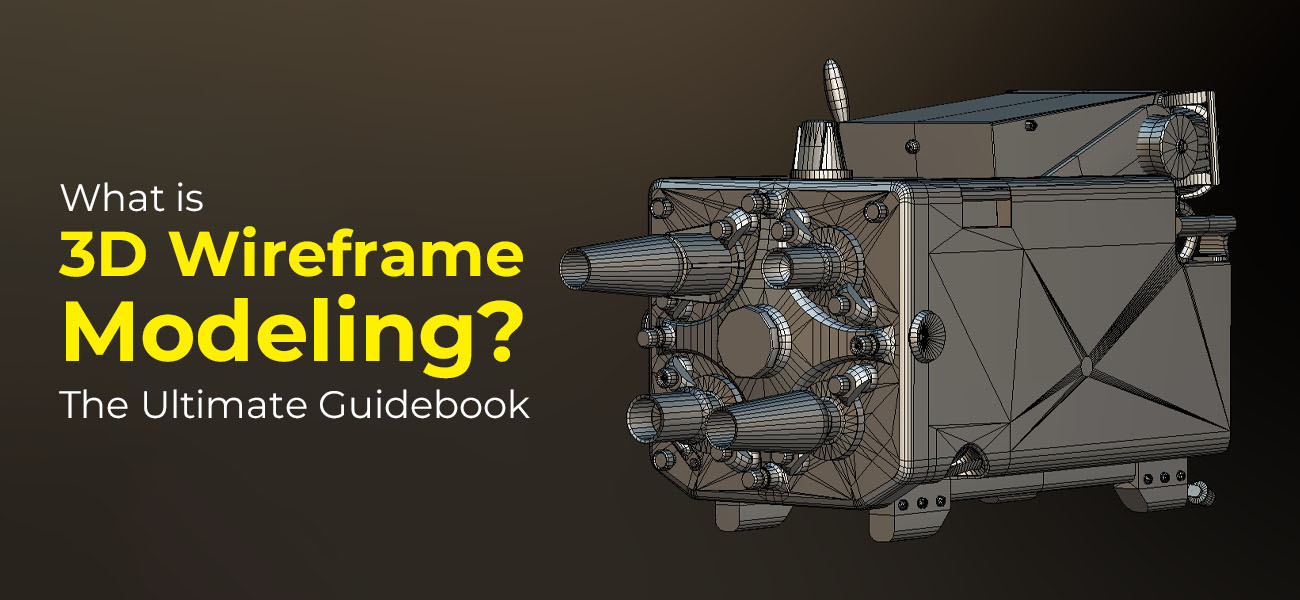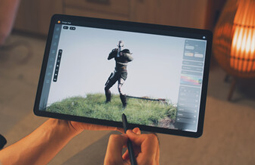What is 3D Wireframe Modeling? The Ultimate Guidebook
The realms of 3D graphics and computer-aided design (CAD) are dynamic and have been integral to the modern scheme of things. In these constantly evolving 3D technologies, 3D wireframe modelling plays a significant part in visualizing three-dimensional objects.
Being a foundational framework for 3D digital designs, wireframe 3D modelling focuses primarily on the essential geometric components.
This article will break down the various aspects of 3D wireframing technique and how it enables rapid visualization of 3D concepts.
It will also discuss the manifold benefits the method bestows upon business sectors. Embark on a journey with us and explore this three-dimensional representation technique in further detail.

What is 3D wireframe modeling?
3D wireframe modelling is a foundational process or technique of 3D graphic visual representation through a simplified framework of curves and lines. A wireframe modeler creates a geometric skeletal replica of a physical object using circles, curves, lines, arcs, and other shapes.
These lines and shapes define the points of the object in a detailed manner, despite being simplistic. This skeletal depiction acts as a visual guide for 3D designers and product engineers.
Surface modeling, or solid modeling, is a more intricate 3D modelling process than the wireframe modelling technique. Hence, the latter is more prominently used throughout several business sectors, especially in architecture, production engineering, video game development, and industrial design workflows.
It is a crucial method for architectural, engineering, or product development projects, especially in the initial period. Wireframe models are ideal for creating basic 3D graphics, assessing object proportions, and facilitating rapid design changes.
What are the practical benefits of wireframe 3D modeling?
The benefits or advantages of 3D model wireframing are manifold and cover a wide range of industries. Mostly because of the technique’s accuracy during the early production and development stages. Designers can swiftly design and assess spatial relationships with the help of streamlined visualization.
The best part of wireframe models is that anyone with zero technical expertise or formal training can understand the proposed concepts.
Let’s discuss the multi-faceted benefits of technology across various sectors.
-
Perform quick design experiments
As 3D wireframe models are made of simple structures and shapes and are not at all focused on complex textures and colors, it is easier to use these models for quick experiments. This comes in handy to industrial designers before they get into the more complex and detailed surface and solid modelling methods.
-
View the models from multiple viewpoints
3D modelers can zoom in, expand, assess spatial distances and relationships between edges and corners, check potential interferences, etc., with wireframe digital models. Furthermore, the models can be used for auxiliary and orthographic perspective views and angles.
-
Viewing reference geometry becomes easy
Leveraging this 3D modeling procedure, designers and modelers can view the reference geometry of a 3D solid, surface, and mesh. Reference geometries are crucial for incorporating axes, the center of mass, planes, reference points, and mate preferences.
-
Wireframe models facilitate team collaboration
Wireframe models are ideal for working in a collaborative environment, facilitating transparent communication between team members. Each member of the team can get an uncluttered view of the design with immense clarity. This transparency prevents any kind of misinterpretation or misunderstanding among the persons involved in the entire project lifecycle.
-
More efficient data storage and rapid rendering
Since wireframe models are inherently made of simple shapes and structures, the file sizes of these models are relatively smaller than those of digital models developed through other methods. As a result of them being extremely lightweight, data storage becomes highly efficient. As well, the rendering time is a lot faster, given the reduced file size, yielding a seamless user experience.
-
Adding surface textures is easy in wireframe modeling
Often, 3D wireframe modeling requires a greater amount of graphical detail and natural textures. This is especially true for 3D video game assets and characters that are made with life-like detailing. Wireframing helps designers quickly add texture during the initial phase and evaluate the objects at any desired position.
In short, the overall importance of wireframing lies in the fact that:
- Modelers can expedite the design process
- Can generate as many perspective views and angles
- Add heavy textures to the models with ease
- Store data efficiently with a quick rendering time
- Create a more collaborative and transparent team communication process
Thus, the wireframing method is one of the most versatile foundations for refining and representing complex 3D structures and concepts across diverse industries.
How do 3D wireframe modeling, surface modeling, and solid modeling differ?
Let’s explore the differences between 3D wireframing, solid modeling, and surface modeling with detailed explanations for each of the techniques.
-
Solid modeling

As we know, solid modeling is a 3D object representation technique that shows the object and its interiors as cubes, spheres, and n-sided prisms. Simply put, objects appear as enclosed, whole solid volumes and not just the surface. Unlike other modeling procedures, the digital models created in this technique cannot be hollow; the density and mass of the models are realistically represented.
The solid modeling method is mainly applicable for developing engineering and manufacturing product models/prototypes in CAD, wherein an object’s physical metrics are the most crucial.
-
Surface modeling

This is another CAD modeling process that defines the surfaces of a three-dimensional object through mathematical equations. The representation of the object’s curves and surfaces happens without enclosing a volume and is ideal for handling more complex shapes.
Although surface modeling doesn’t represent complete object volume, it still captures more detail than the wireframing technique and allows precise control over the surface shapes. Therefore, this model creation procedure is best suited for designing automotives, aircraft, or consumer products/electronics parts that have complex shapes and structures.
-
3D wireframe modeling

In comparison to the two modeling techniques above, wireframe modeling is simpler and more efficient for early design stages. This technique represents digital models through a simple skeletal framework of lines and curves without defining surfaces or volumes. It mainly focuses on the contours and edges of the object and is ideal for design conceptualization.
The lightweight models generated are computationally efficient, perfect for data storage, and enable rapid prototyping. Wireframe models are most commonly used in the initial design phase of architectural and industrial designs.
Disadvantages of wireframe 3D modeling technique
While the 3D wireframing technique has several benefits and applications, there are still a few drawbacks that 3D professionals must know. That’s why it is important to identify the best technique depending on specific contexts, project requirements, and the level of realism and details required.
Very little realism – One of the primary disadvantages of 3D wireframe modeling is that very little realism and detailing are achieved through it. Unlike other modeling techniques, wireframes fail to convey realistic visual representations of objects, such as textures, lighting effects, shading, etc. This limits the technique’s application where realism is key.
Difficulty in visualization - Since the depth of perception and spatial relationships are challenging in wireframe models, it is difficult for modelers to visualize the concept. Without these visual cues, precise representation of complex structures is challenging in wireframe modeling.
Limited rendering options - Although rendering happens at a fast pace, there are limitations in visualization options given the absence of surface information. Wireframe models cannot be rendered in different styles or lifestyle approaches. If aesthetic and sophisticated product visualization is required for any project, it is difficult to wireframe.
Final words
To sum up this ultimate guidebook for 3D wireframe modeling, the technique is widely accepted and implemented across diverse business sectors. It has emerged as a cornerstone for CGIs and 3D graphics and facilitates swift design iteration and the creative process. Multidisciplinary teams can benefit from transparent and clear communication and clear visual framework. From architecture, automotive, and industrial designs to 3D designs and game development, wireframe 3D models are fundamental in the dynamic world of digital design.
However, as mentioned, there are a few drawbacks to this technique that somewhat limit its applications in projects where intricate detailing and realism are prerequisites. However, as the technologies advance further, we can hope this constraint can also be resolved. There are several 3D modeling software that help users execute the process effectively. As a substitute option, there are also several professional 3D service providers on the market offering stellar digital modeling solutions.
So, whether you are a beginner, an intermediate, or a professional, incorporate wireframe models in your workflow for quick design conceptualization, an easy iteration process, and more efficient data storage. Good luck!







